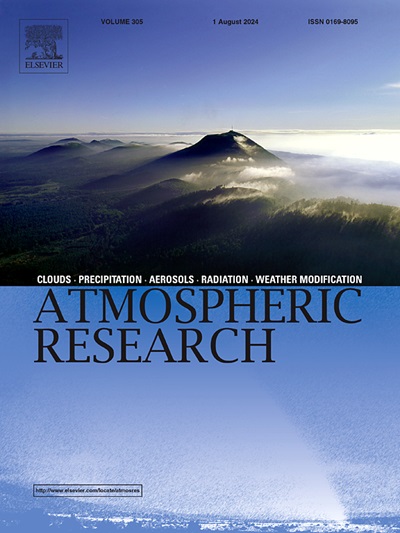Assessing the influence of climate change on multiple climate indices in Nepal using CMIP6 global climate models
IF 4.5
2区 地球科学
Q1 METEOROLOGY & ATMOSPHERIC SCIENCES
引用次数: 0
Abstract
Global climate models (GCMs) serve as essential tools for projecting future climate trends, but their coarse resolution limits localized impact assessments in sectors like hydrology, agriculture, and biodiversity. Observation data with a spatial resolution of a few kilometers are crucial for downscaling and bias-correcting GCMs at finer resolutions. However, Nepal's extreme topography and organizational challenges have led to uneven distribution of meteorological stations and inconsistent data quality. Moreover, CMIP6-based climate extremes projections for the entire country are currently unavailable. To tackle these challenges, we developed a comprehensive national database for Nepal, offering high-resolution historical and projected precipitation and temperature data analyzed through 25 climate extreme indices from the Expert Team on Climate Change Detection and Indices (ETCCDI). Initially, observation grid data were prepared at a daily timescale with a spatial resolution of 0.05° × 0.05° for baseline period (1981–2010) using the Asian Precipitation High-Resolved Observational Data Integration Toward Evaluation (APHRODITE), the fifth generation of the European Centre for Medium-Range Weather Forecasts Reanalysis (ERA5), and available good quality observed climate data. This data was then utilized to downscale and bias-correct 18 CMIP6 GCMs for 2015–2100 under four SSPs (1–2.6, 2–4.5, 3–7.0, 5–8.5). Quantile mapping was employed for the bias correction of the CMIP6 GCMs. The performance of the multimodal ensemble (MME) indicated better Nash-Sutcliffe Efficiency (NSE), root mean square error ratio (RSR), and Percent Bias (PBIAS) of climate extreme indices for the historical period. A comparative analysis was conducted across Nepal's major geographic regions to account for spatial variability in regional climate systems. The finer-resolution dataset can be crucial to deepen our understanding of climate impacts, and climate change, and eventually informing the policy-making in Nepal. Moreover, the methodology can be effectively replicated in data-scarce developing nations to promote climate research and adaptation efforts.
利用 CMIP6 全球气候模型评估气候变化对尼泊尔多种气候指数的影响
全球气候模型(GCM)是预测未来气候趋势的重要工具,但其粗糙的分辨率限制了对水文、农业和生物多样性等领域的局部影响评估。空间分辨率为几千米的观测数据对于更精细分辨率的 GCM 的降尺度和偏差校正至关重要。然而,尼泊尔的极端地形和组织方面的挑战导致气象站分布不均和数据质量不一致。此外,目前还没有基于 CMIP6 的全国极端气候预测数据。为了应对这些挑战,我们为尼泊尔开发了一个全面的国家数据库,提供高分辨率的历史和预测降水和温度数据,并通过气候变化探测和指数专家组(ETCCDI)的 25 个气候极端指数进行分析。首先,利用亚洲降水高分辨率观测数据整合评估(APHRODITE)、第五代欧洲中期天气预报再分析中心(ERA5)和现有优质观测气候数据,编制了基线期(1981-2010 年)空间分辨率为 0.05° × 0.05° 的日时间尺度观测网格数据。然后,利用这些数据对 18 个 CMIP6 GCM 进行降尺度和偏差校正,得出四个 SSP(1-2.6、2-4.5、3-7.0、5-8.5)下 2015-2100 年的数据。对 CMIP6 GCM 的偏差校正采用了量子映射法。多模式集合(MME)的性能表明,历史时期气候极端指数的纳什-萨特克利夫效率(NSE)、均方根误差比(RSR)和偏差百分比(PBIAS)都更好。对尼泊尔主要地理区域进行了比较分析,以考虑区域气候系统的空间变异性。更高分辨率的数据集对于加深我们对气候影响和气候变化的理解至关重要,并最终为尼泊尔的政策制定提供信息。此外,这种方法可以有效地推广到数据稀缺的发展中国家,以促进气候研究和适应工作。
本文章由计算机程序翻译,如有差异,请以英文原文为准。
求助全文
约1分钟内获得全文
求助全文
来源期刊

Atmospheric Research
地学-气象与大气科学
CiteScore
9.40
自引率
10.90%
发文量
460
审稿时长
47 days
期刊介绍:
The journal publishes scientific papers (research papers, review articles, letters and notes) dealing with the part of the atmosphere where meteorological events occur. Attention is given to all processes extending from the earth surface to the tropopause, but special emphasis continues to be devoted to the physics of clouds, mesoscale meteorology and air pollution, i.e. atmospheric aerosols; microphysical processes; cloud dynamics and thermodynamics; numerical simulation, climatology, climate change and weather modification.
 求助内容:
求助内容: 应助结果提醒方式:
应助结果提醒方式:


